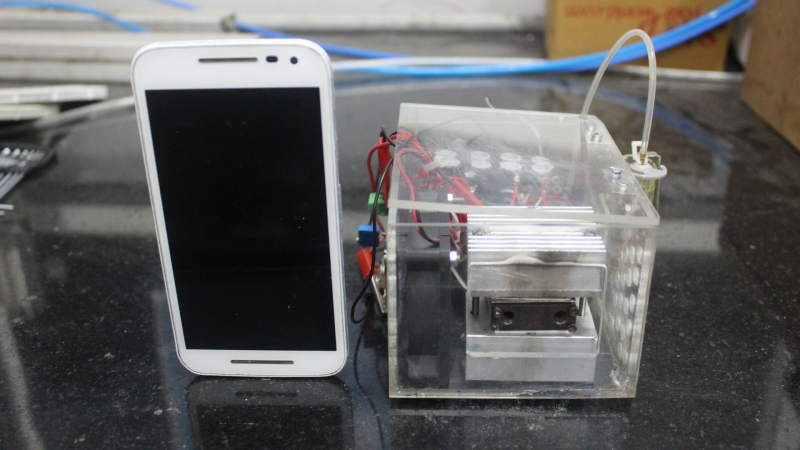
Researchers design a compact and efficient micro-combustor that powers small electronics
Scientists around the world have been actively looking for eco-friendly alternatives to conventional chemical-based batteries. In one such effort, researchers at the Indian Institute of Technology Bombay (IIT Bombay) have designed a micro-combustor that is efficient and environment-friendly. The study, funded by the Science and Engineering Board (SERB) and Department of Science and Technology (DST), has been published in various journals including Applied Physics Letters, Energy Conversion and Management, and Applied Energy.
Batteries are quintessential in making the giant leap from immobile computers and telephones to portable laptops and cell phones. While they have revolutionised how the world is connected, these batteries have taken a toll on our environment. Most of them contain heavy metals, like nickel, cobalt and lead, which leak into the soil on disposal. Plants then absorb these toxic metals, resulting in their accumulation in the food chain. When consumed in large concentrations, these metals are harmful and can impede the functions of our body.
Micro-combustors are mini-fuel engines that are smaller than a pen. These combustors burn fuels like the Liquified Petroleum Gas (LPG), used in the kitchen, to produce heat, which is then harvested to generate electricity. They are also more environment-friendly than commonly-used batteries.
“Although the environmental hazards associated with fuel-based power sources might be a cause for concern, the amount of carbon dioxide and water emissions from a micro-combustor in a day is significantly lower than that emitted by an average human being,” says Mr B Aravind, a researcher at IIT Bombay and an author of the study.
Since a micro-combustor relies on continuous fuel supply, they do not need to be recharged and hence provide a constant amount of power.
In collaboration with Prof. Bhupendra Khandelwal from the University of Sheffield, UK, Prof. Sudarshan Kumar at IIT Bombay and his team of researchers have designed a dual micro-combustor. Here, two small micro-combustors are placed together instead of a single micro-combustor, so that the heat generated from the two flames is spread-out. As a result, the heat can be better harvested, and the device can generate more electricity from the same amount of fuel as compared to existing micro-combustors. It is also very compact without compromising on the power produced.
A significant challenge of micro-combustors lies in ensuring that the flames don’t extinguish for a long time.
“In small scale combustors, the flame is tiny, and the heat generated is minimal compared to the heat loss. The flame will then likely quench because of higher heat dissipation,” explains Mr Aravind.
This situation is similar to how we would struggle to keep a small bonfire burning on a windy night. The researchers addressed this problem by stuffing ceramic wool between the burning chamber and the exhaust gas outlet, thereby stabilising the flame. Ceramic wool is porous to the exhaust gases, but it slows down the rate at which these gases are expelled. In this process, it traps some heat from the ejected gas to pre-heat the incoming, cold fuel, which ignites faster on warming.
“The use of porous materials like ceramic wool, silicon carbide and many more in micro-combustors has much scope and is relatively unexplored,” says Mr Aravind.
The new design thus uses the heat in the exhaust gas, which would’ve otherwise gone waste.

Image credits - Prof. Sudarshan Kumar, IIT Bombay
As another measure to stabilise the flame, the researchers designed the walls of the burning chamber as a series of widening steps. This sudden increase in the chamber size at each step disturbs the flow of fuel and makes it uneven. Subsequently, tiny currents are formed at these steps, and the flow slows down.
“We need to hold the fuel inside the micro-combustor for longer to burn it completely and extract more,” reasons Mr Aravind on their stepped chamber design. “Manufacturing a stepped chamber is easy as it involves simple drilling,” he adds.
The newly-designed dual micro-combustor can generate up to 4W of power, sufficient to charge a mobile phone. Prof. Kumar’s team is now developing newer designs to quadruple this output so that bigger gadgets like laptops can also be charged. However, there is still a long way to go before these micro-combustors end up in our homes. Today, they require many, bulky, additional equipment like oxygen supply tanks and thermoelectric generator modules that produce electricity from the heat. So, the researchers are working on self-aspirating micro-combustors that do away with the oxygen tanks and instead, extract it from the atmosphere.
“The final goal is to develop a standalone, cheap and reliable micro-combustor based power generator that is portable and can be commercially manufactured,” concludes Mr Aravind.
This article has been run past the researchers, whose work is covered, to ensure accuracy.

























